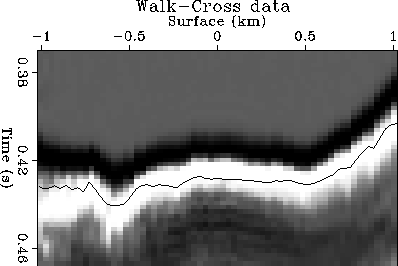




Next: CONCLUSIONS
Up: APPLICATIONS
Previous: Picking sea bottom reflections
The common receiver gather used in this example was recorded in a marine
Walk-cross survey, in which, a receiver was loaded down into
a bore-hole. The receiver records the waves generated by the shots along the
surface. If the medium above the receiver were homogeneous, the first arrival
on the common receiver gather would follow a hyperbola.
We fitted a hyperbola to the first arrival on this gather and
performed the moveout corrections. Figure ![[*]](http://sepwww.stanford.edu/latex2html/cross_ref_motif.gif) shows
the first arrival after the moveout corrections. The event is not flattened
because the actual medium is not homogeneous. The residual time shifts of the
event can be used to estimate the velocity anomalies of the media. We then
applied our algorithm to estimate the residual shifts. The result is
superposed on the event. Figure
shows
the first arrival after the moveout corrections. The event is not flattened
because the actual medium is not homogeneous. The residual time shifts of the
event can be used to estimate the velocity anomalies of the media. We then
applied our algorithm to estimate the residual shifts. The result is
superposed on the event. Figure ![[*]](http://sepwww.stanford.edu/latex2html/cross_ref_motif.gif) compares the wavelets of the
event before and after residual shift corrections. The wavelets do not
line up perfectly at a point because their waveforms
are distorted from one another.
vsppick
compares the wavelets of the
event before and after residual shift corrections. The wavelets do not
line up perfectly at a point because their waveforms
are distorted from one another.
vsppick
Figure 6 Picked residual shifts of the first arrival.




 vspcor
vspcor
Figure 7 Wavelets before (left) and after (right) the residual shift corrections.










Next: CONCLUSIONS
Up: APPLICATIONS
Previous: Picking sea bottom reflections
Stanford Exploration Project
12/18/1997

![[*]](http://sepwww.stanford.edu/latex2html/cross_ref_motif.gif) shows
the first arrival after the moveout corrections. The event is not flattened
because the actual medium is not homogeneous. The residual time shifts of the
event can be used to estimate the velocity anomalies of the media. We then
applied our algorithm to estimate the residual shifts. The result is
superposed on the event. Figure
shows
the first arrival after the moveout corrections. The event is not flattened
because the actual medium is not homogeneous. The residual time shifts of the
event can be used to estimate the velocity anomalies of the media. We then
applied our algorithm to estimate the residual shifts. The result is
superposed on the event. Figure ![[*]](http://sepwww.stanford.edu/latex2html/cross_ref_motif.gif) compares the wavelets of the
event before and after residual shift corrections. The wavelets do not
line up perfectly at a point because their waveforms
are distorted from one another.
compares the wavelets of the
event before and after residual shift corrections. The wavelets do not
line up perfectly at a point because their waveforms
are distorted from one another.

